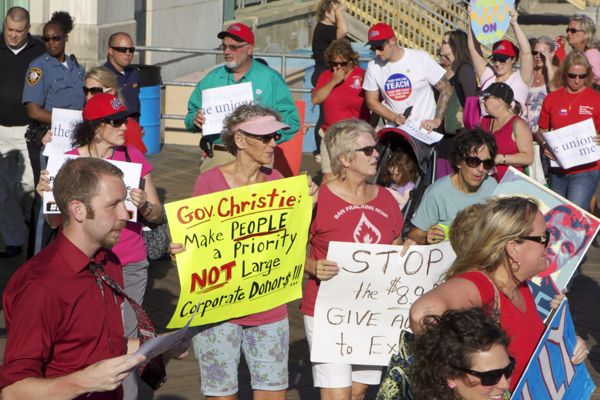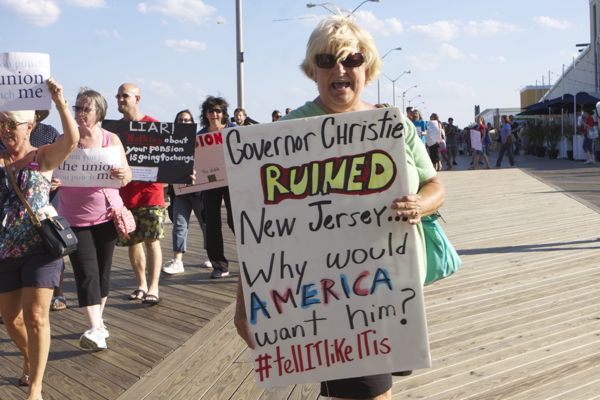Christie DEP Fails To Require Cooling Towers, Despite Slaughter of 3 Billion Fish Per Year
Nuke Plant Is “Pasteurizing” Delaware Bay

Bill Wolf (sic), a former NJDEP worker, testifies during a public hearing hosted by the NJDEP regarding a water permit for PSEG Nuclear at the Old Courthouse in Salem, Wednesday, Aug. 5, 2015 (Joe Warner | For NJ.com)
Part One – The Framework Is Broken
Before we begin this long story, check this timing out – it completely exposes the corruption.
First, PSEG CEO shamelessly brags about the deal:
During an investor briefing, Izzo said that company officials have reopened talks with New Jersey’s Department of Environmental Protection on updating a long-expired, long-controversial cooling water intake permit for Salem. The development came shortly after federal regulators finalized new rules for choosing protective technologies for power plant intakes.
“The ink wasn’t dry” on the regulations “when we called up DEP and said, ‘Let’s talk about the permits,'” Izzo said. ~~~ Delaware Online (8/4/14)
Then, DEP brazenly and openly confirms the deal – note the EPA’s Oct. 14, 2014 date discussed below with respect to Izzo’s comment:
As part of the issuance of the final regulations, EPA distributed guidance regarding the implementation of federal regulations with respect to the timing of the regulations and applicable requirements. Specifically, EPA stated that if the Director (e.g. state permitting authority) began a permit renewal prior to October 14, 2014 (before the effective date of the final rule), the Director may issue a permit based on the information already supplied by the applicant without the need to supplement to meet additional reporting and study requirements of the new regulations, so long as the permit is issued before July 14, 2018. ~~~ (DEP draft permit, page 13)
Did you get that? If PSEG came in before October 14, 2014, they were basically good to go. No wonder Mr. Izzo and DEP were in a hurry. So let’s repeat that:
EPA stated that if the Director (e.g. state permitting authority) began a permit renewal prior to October 14, 2014 (before the effective date of the final rule), the Director may issue a permit based on the information already supplied by the applicant without the need to supplement to meet additional reporting and study requirements of the new regulations, so long as the permit is issued before July 14, 2018.
The DEP refused to renew the expired permit for almost a decade – but, when the timing worked to the benefit of PSEG to avoid a $1 billion cooling tower requirement, the corrupt Christie DEP acted immediately.
I guess they think no one reads the fine print and connects the dots. They may be right.
The DEP Draft Permit and its tortured history
1) The Original Whitman DEP 1994 PSEG Permit Cut the Deal
The DEP initially issued a draft permit that required cooling towers at the Salem plant.
But, like the later Oyster Creek cooling tower permit, that draft permit was not finalized, for political reasons and objections by PSEG.
Instead, in 1994, the DEP issued a final permit that did not require cooling towers and instead relied on “special conditions”, primarily wetlands restoration as mitigation for the fish kills:
A NJPDES permit for this facility was issued to PSE&G-Salem Generating Station (the permittee at that time) on July 20, 1994 with an expiration date of August 31, 1999. In its July 20, 1994 NJPDES permit, the Department granted PSE&G’s request for a variance pursuant to Section 316(a) and proposed thermal limits which would allow the continued operation of the existing once-through cooling system. With regard to Section 316(b), the Department determined that “best technology available” (BTA) consisted of the existing CWIS, modifications to the intake screens and an improved fish bucket design; a restriction on cooling water intake flow; and a sound deterrent study. The Department also required a variety of other “Special Conditions”.
-
Special Conditions Requiring Actions in the Estuary to Produce Fish – undertake a wetlands program to restore and/or preserve at least 8,000 acres of wetlands, plus 2,000 acres of additional wetlands or 6,000 acres of associated upland buffers, or a combination thereof based on a 1:3 wetlands/uplands buffer acreage ratio. The permit also required a Deed of Conservation Restriction to preserve up to 18,500 acres of lands, wetlands and uplands including the 4,500 acre Bayside Tract. The permit further required PSE&G to install five fish ladders to eliminate barriers to migration for anadromous fish. […]The wetlands restoration program was intended to increase fish productivity in the Delaware Estuary. The amount of acreage selected for the program was determined and mandated in the July 20, 1994 permit by determining the amount of Spartina and other associated plants that would be produced each year and the resulting detrital plant biomass available in Delaware Bay by decomposition by fungi, bacteria and other micro-organisms. These in turn would be consumed by zooplankton and various small invertebrates which forms the food base for fish. These ecological concepts, along with specific quantities, formed the basis of the aggregated food chain model and was used to translate estimated fish losses at the Station to acres of wetlands required to adequately mitigate those losses.
-
The Department calculated that a minimum of 7,487 acres should be restored to increase fish productivity to a level that equals the fish estimated to be lost at the cooling water intake structure. The permittee proposed to restore a minimum of 10,000 acres to provided added assurance that fish production will be increased to sufficient levels to mitigate the effect of PSEG-Salem related losses.
Got that? Do you think that restoration of existing wetlands can produce incremental ecological productivity increases that offset the slaughter of 3 billion fish per year? No way.
2) The Whitman DEP 2001 Renewal Permit Perpetuates The Deal
Here’s the DEP’s cover story about the 1994 deal:
Consistent with the 1994 NJPDES permit, the Department did not designate the wetlands restoration program and fish ladder requirements as best technology available under Section 316(b) nor were these actions required in lieu of cooling towers. The Department incorporated this plan, after it was proposed by PSEG outside of what was required under Section 316(b), as a special condition to the permit because of its environmental benefits and because it would continue to help minimize the potential for adverse impact from the CWIS. PSEG established the Estuary Enhancement Program (EEP), which is described in greater detail later in this document, to implement these requirements as well as other permit requirements.
Of course the wetlands restoration were in lieu of cooling towers. The DEP created the cover story because the deal violates the Clean Water Act and they can not legally defend it. Mitigation is not “best available technology” and they know it.
But, as is equally obvious, the DEP based its decision on the high cost of cooling towers:
The Department issued a NJPDES permit renewal on June 29, 2001 which became effective August 1, 2001. The Department determined that closed-cycle cooling was not an available technology for Salem because the costs of retrofitting the Salem plant with this technology were wholly disproportionate to the additional environmental benefits as compared to the state-of-the-art modified Ristroph traveling screens already installed at the Station. Specifically, the Department accepted PSEG’s estimates that retrofit of cooling towers would involve a complicated and wide-scale construction project involving substantial costs. Those costs in the March 4, 1999 application were estimated at $712,000,000 for a natural draft cooling tower and $849,200,000 for mechanical draft cooling towers. The Department also determined that the evidence of record indicated that retrofitting closed-cycle cooling would result in increased air pollution and other potential adverse environmental impacts.
Get that? The private costs to PSEG for installing cooling towers to stop the slaughter are more important that all the public costs due to impacts on the Bay and fishery. Privatize the profits, socialize the costs. Capitalism and deregulation at work.
3) The Christie DEP 2015 Renewal Allows PSEG To Exploit EPA Loopholes
After the 2001 permit was issued, there was litigation by environmental groups and a US Supreme Court decision that resulted in EPA adopting new rules under the Clean Water Act
The Obama EPA rules, spearheaded by Lis Jackson, failed to require that old nuke and other power plants retrofit with cooling towers as “best available technology” under the Clean Water Act.
EPA punted those decisions to state regulators.
The NJ Department of Environmental Protection (DEP) held a public hearing yesterday in Salem NJ on a draft NJPDES water permit for the PSEG’s Salem nuclear power plant, which takes over 3 BILLION gallons of water a day from the Delaware River for cooling the plant:
This draft permit renewal proposes to incorporate the Department’s determination with respect to the permittee’s request for a thermal variance from surface water quality standards for heat and temperature pursuant to Section 316(a) of the Federal Water Pollution Control Act, 33 U.S.C. Section 1251 et seq. (Clean Water Act). Further, this draft renewal permit proposes to incorporate the Department’s determination pursuant to Section 316 (b) of the Clean Water Act regarding the best technology available for the cooling water intake structure and incorporates the requirements of the newly effective federal Section 316(b) regulations.
In a recent devastating Op-Ed, a retired DEP professional wrote that the PSEG nuke plant was slaughtering so many fish and aquatic life that the plant was essentially “pasteurizing” Delaware Bay:
The Salem Nuclear Power Plant is essentially pasteurizing the Delaware Bay.
I was employed by the New Jersey Department of Environmental Protection for my entire career, and I have to tell you and your readers that I think it is utterly criminal for the current DEP administration to allow PSE&G to continue to slaughter these natural resources that belong to all of us, not to a corporation.
Here is how the DEP regulatory jargon explains this slaughter and pasteurization process:
The majority of environmental impacts associated with intake structures are caused by water withdrawals that ultimately result in aquatic organism losses. In that regard, cooling water intakes can have two types of effects, namely impingement and entrainment.
Impingement takes place when organisms are trapped against intake screens by the force of the water passing through the CWIS. Impingement can result in starvation and exhaustion (organisms are trapped against an intake screen or other barrier at the entrance to the CWIS), asphyxiation (organisms are pressed against an intake screen or other barrier at the entrance to the CWIS by velocity forces that prevent proper gill movement, or organisms are removed from the water for prolonged periods of time), and descaling (fish lose scales when removed from an intake screen by a wash system) as well as other physical harm.
Entrainment occurs when organisms are drawn through the CWIS into the cooling system. Organisms that become entrained are normally relatively small benthic, planktonic, and nektonic organisms, including early life stages of fish and shellfish. Many of these small organisms serve as prey for larger organisms that are found higher on the food chain. As entrained organisms pass through a plant’s cooling system they are subject to mechanical, thermal, and/or toxic stress. Sources of such stress include physical impacts in the pumps and condenser tubing, pressure changes caused by diversion of the cooling water into the plant or by the hydraulic effects of the condensers, shear stress, and chemical toxemia induced by antifouling agents such as chlorine.
Back in October 2013, environmental groups, including Sierra Club, Delaware Riverkeeper sued the DEP to force them to issue a permit renewal.
Impacts on Threatened and Endangered Species Don’t Matter
For those who read the fine print in a permit, it rapidly becomes clear that the rules are written to benefit the polluters. It can be quite discouraging, so be forewarned.
Check this one out – EPA ESA regulations explicitly refused to let T&E impacts stop of significantly change the nuke plant:
Among the recommendations that may be made by the [USFWS and NMFS] Services to the facility and the Director are measures to minimize incidental take. EPA expects that any measures the Services recommend to minimize incidental take will be consistent with ESA regulations and guidance, which state at 50 CFR 402.14(i)(2), “Reasonable and prudent measures, along with the terms and conditions that implement them, cannot alter the basic design, location, scope, duration, or timing of the action and may involve only minor changes.” EPA does not expect that installation of closed-cycle cooling would be specified as a measure solely for the purposes of minimizing incidental take.
You got that? That’s the equivalent of telling USFWS and NMFS biologists to sit-down and shut up. Protection of T&E “may involve only minor changes”, certainly not a $1 billion cooling tower decision. Right.
But that really doesn’t matter, because the federal agencies are in the tank for the energy industry and have been neutered:
The Department shared the 2006 PSEG NJPDES renewal application with USFWS as well as the NMFS. Specifically, the Department sent electronic copies of the application to Christine Vaccaro, Fisheries Biologist for NMFS on February 2, 2015 and to Eric Schrading of the USFWS on January 21, 2015. On April 3, 2015, Steve Mars of the USFWS completed this consultation with a finding of no federal threatened and endangered species in the project area that is under USFWS jurisdiction. As a result, USFWS did not provide any additional input or suggested control measures. No comments were received on the permit application from the NMFS at the time of the draft permit issuance.
Sickening. You see, NMFS biologists realized that it was futile:
When the Nuclear Regulatory Commission extended PSEG-Salem Unit 1 and Unit 2 licenses in 2014, the NMFS issued a biological opinion for the continued operation of the Station (see www.greateratlantic.fisheries.noaa.gov/protected/section7/bo/actbiops/salemhcnmfsfinalbiopjuly172014.pdf). This biological opinion was required by Section 7 of the ESA, which directs federal agencies to consult with the Services before approving an action that will affect an ESA-listed species. In its July 2014 biological opinion, NMFS concluded that license extension by NRC to permit the Station to continue operating with once-through cooling “may adversely affect but is not likely to jeopardize the continued existence of any [ESA] listed species.” As a condition to exempting “incidental takes” of ESA listed species by the PSEG-Salem CWIS, particularly sea turtles and sturgeon, NMFS is requiring PSEG-Salem to undertake certain Reasonable and Prudent Measures (RPMs) to minimize and monitor incidental takes. These RPMs are described in NMFS’s biological opinion and compliance will be ensured by USNRC.
The Game Is Rigged. The system is broken.
Or check the variance (loophole) provided for restrictions on warming the water, regardless of whether it kills all the life in the water (and this “loophole” is supposed to consider the additive effects and cumulative impacts of not only temperature increase, but also withdrawal, impingement, and entrainment, assuring no “appreciable harm” to the “balanced indigenous community“)
All discharges from the Station are to the main stem of the Delaware River; therefore, the thermal standards listed in the Delaware River Basin Commission’s (DRBC) Water Quality Regulations apply. Section 3.30.5.C.2 of the DRBC Administrative Manual-Part III, Water Quality Regulations (December 4, 2013) lists the Stream Quality Objectives for temperature for Zone 5 of the Delaware River. These regulations require that the water temperature in the receiving water not be raised by more than 4oF (2.2oC) during the period from September through May and no more than 1.5oF (0.8oC) during the period from June through August, nor shall the maximum temperature exceed 86oF (30oC), except in designated heat dissipation areas (HDAs). Section 4.30.6.F.4 of DRBC’s Administrative Manual-Part III, Water Quality Regulations (December 4, 2013) defines the dimensions of the HDA for Zone 5 (the regulatory HDA). It states that as a guideline, HDAs shall not be longer than 3,500 feet, measured from the point where the waste discharge enters the stream. In the event that these limits cannot be met at the discharge point or within the defined heat dissipation area, then the permittee can request a Section 316(a) variance which would allow an alternative effluent limit for temperature.
PSEG requires a Section 316(a) variance from the SWQS because temperature changes (∆T’s) due to the station’s thermal discharge exceed the Stream Quality Objectives for temperature beyond the regulatory HAD for part or all of the year. Section 316(a) of the CWA applies to point sources with thermal discharges. It authorizes the National Pollutant Discharge Elimination System (NPDES) permitting authority to impose alternative effluent limitations for the control of the thermal component of a discharge in lieu of the effluent limits that would otherwise be required under sections 301 or 306 of the CWA. Specifically, Section 316(a) authorizes variances from thermal SWQS where it is shown that the alternative limit proposed will “assure the protection and propagation of a balanced, indigenous population of shellfish, fish, and wildlife” in the receiving water.
Slaughter of 3 billion fish per year – what a DEP professional described as “pasteurization” of the Bay – including incidental take of sea turtles and sturgeon “assure[s] the protection and propagation of a balanced, indigenous population of shellfish, fish, and wildlife” and no appreciable harm to the balanced indigenous community.
Got that? Right.
We’ll end Part I here.
Coming Soon: Part II – AWOL – How NJ Conservation Groups Sold Out Delaware Bay












